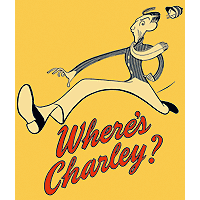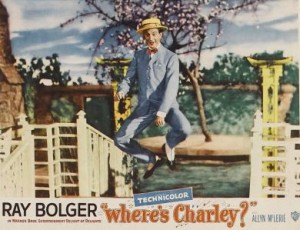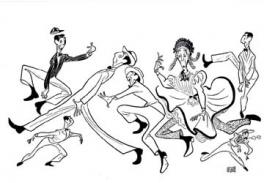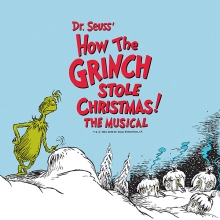Filichia Features: Here's Charley!
Filichia Features: Here's Charley!
 Like Mrs. Lovett, “Sometimes ideas just pop into me head.” Only mine are more benign than hers, thank the Lord.
Like Mrs. Lovett, “Sometimes ideas just pop into me head.” Only mine are more benign than hers, thank the Lord.
With Encores! announcing its 2012-2013 season this week – Fiorello followed by It’s a Bird …It’s a Plane … It’s Superman and then On Your Toes – I started thinking about George Abbott. After all, he was Fiorello’s co-author and director; the mentor of Hal Prince, who produced and directed Superman; and the co-author of On Your Toes.
The leading man of the last-named show was Ray Bolger. He’ll now and forever be known as The Scarecrow in The Wizard of Oz, of course, but his biggest Broadway success came with Abbott in 1948, in Where's Charley? – the musical of Brandon Thomas’ warhorse comedy Charley’s Aunt. Encores! did it last year. See how all these thoughts join together?
Where's Charley? is a musical that should be done more often. When its original production (1948-1950) closed, it was the eighth-ever-longest-running musical in Broadway history. Even today, 792 performances is a terrific run; 2,278 musicals that have wound up opening on Broadway either before or since wish they could have done as well.
So why isn’t the show done all the time? One reason is that its 1948 original cast album was never made because a musicians’ strike prevented it. A 1958 British cast album was made, and to this day, it’s the only recording that this hit has ever received. In 1993, it was transferred to CD, so it can be found – and Frank Loesser’s score can be savored.
But another reason is that Where's Charley?'s 1952 movie version is rarely shown and has never been made available on tape or DVD. Let’s take a walk through that film and see if it tickles your fancy.
It’s 1892, and we’re at Oxford University. In those Victorian days, a chaperone had to be present whenever young lovers met. (Won’t your young audience members guffaw at that!)
Where's Charley? - Courtesy of the Al Hirschfeld Foundation
So not only are Charley and his pal Jack expecting their respective girlfriends, Amy and Kitty, but they’re also waiting for Charley’s aunt, Dona Lucia D’Alvadorez.
But there is an awkward moment when four young people just happen to thrust together without benefit of chaperone. All four sing that they’d “Better Get Out of Here.” It’s one of my favorite show songs, and I hope it becomes one of yours.
As it turns out, Dona Lucia can’t make it, so Charley -- who had been rehearsing a drag role in a university show, anyway – will pretend to be she. That leaves him with far less time with Amy, but enough time to duet with her in “Make a Miracle,” another one of my favorite show songs that I also hope becomes one of yours.
“Make a Miracle” has Charley and Amy think about the future. Won’t it be nice to have electric lights, fountain pens, horseless carriages -- even horseless carriages that fly and stereopticons that move. All those came to pass, of course, but Loesser also wrote that “Someday, someone rather bright will cure the common cold.” That’s one prediction that hadn’t happened by 1948 – or 2012, for that matter.
Despite Charley’s constantly having to run out and make quick changes and zoom back in again, his bottom line is that he’s happy – because “Once in Love with Amy,” he proclaims, you’re “always in love with Amy.” Charley was so excited that Bolger even broke the fourth wall and commanded his audience, “C’mon and sing it with me!”
The sing-along became the show’s trademark; of the four productions I’ve seen of Where's Charley? – dating back to a 1970 summer stock production that starred Noel (son of Rex) Harrison – each one had Charley encourage the audience to join in. And you didn’t have to ask any of the crowds twice.
It came about through a lovely theatrical accident. Early in the run, co-producer Cy Feuer brought his little son Bobby to see a matinee. The child had heard “Once in Love with Amy” so many times around the house that he knew all the words and could sing along with it – which he decided to do, right there out loud mid-performance.
 Needless to say, a co-producer’s son would have a good seat, and Bolger had no problem spotting the lad. He was charmed by the kid’s knowing the song, and encouraged the audience to sing along with the boy. Abbott decided that Bolger should keep the sing-along for all performances.
Needless to say, a co-producer’s son would have a good seat, and Bolger had no problem spotting the lad. He was charmed by the kid’s knowing the song, and encouraged the audience to sing along with the boy. Abbott decided that Bolger should keep the sing-along for all performances.
He did, and apparently brought a young child on stage whenever one was seated near him. Jim Morgan, the lyricist and co-bookwriter of Quilt A Musical Celebration, was seven years old when his parents decided to travel from Buffalo to give him his first taste of New York City. That included a visit to Where's Charley?. As Morgan once told me, “Bolger came right down into the audience, picked me up and brought me right on stage. Once that happened, I wanted no other life than the theater. How I cried at the end of the trip when my parents insisted that we were going back to Buffalo.”
The sing-along was no small ingredient in spurring Where's Charley? to its two-year run. How fitting that a show whose score included a song called “Make a Miracle” actually made one of its very own.
However, any director thinking about reviving Where's Charley? should get hold of the film to see Bolger’s performance in order to learn what NOT to do, too. Oh, he’s a magnificent dancer, and at one point in “Better Get Out of Here,” he does a dance step that’s so unanticipated and totally effective that you’ll blink in astonishment.
Otherwise, I have issues. On the St. James stage in 1948, the 42-year-old Bolger was probably able to pass as a pupil (from the second balcony, anyway). But on film four years later, he looks as if he’s a student who had to repeat many a grade. Last year at Encores! Rob McClure, a much younger actor – and a wonderfully able one at that – was much more convincing. In other words: cast young.
True, we all have different values when it comes to theatrical conventions, but I can’t abide when a character hesitates and stutters before he’s about to tell a lie – and then no one else on stage can see through it. I also have no tolerance whatsoever when nary a character can see through an all-too-obvious disguise, for that makes me lose respect for each of them. Both of these show up in the Where's Charley? film, but I hope that they don’t surface in your production.
This may sound far afield, but I urge all directors to see the 1972 film version (and NOT the 2007 remake) of The Heartbreak Kid. There are many scenes in which a husband lies to his wife. His fibs become more and more preposterous, but because the husband (hilariously played by Charles Grodin) never, ever hesitates or stumbles in any way before he lies, his wife (the equally funny Jeannie Berlin) winds up believing him. His no-holes-barred approach is far more believable than the all-too-often used “Ahhh … ahhh … ummm … ummm … well … you see … here’s what happened – yeah!” before the lie finally comes out.
Yes, there are audiences that have come to accept this convention of he-who-hesitates-is-believed; they enjoy feeling smarter than the characters on stage. But give your audiences a chance to see a “Dona Lucia” who always has the answers and gives them without a moment’s hesitation. Audiences like when characters are smarter than they are, too.
Bolger also let Charley’s natural masculinity all-too-baldly come through. When he spoke as her for the first time, he used his regular deep voice. He did this every now and then when he forgot who he was supposed to be. And every character all-too-conveniently thought nothing of it.
Chances are that your audiences may be a little smarter than those that originally visited Where's Charley?. Thus, make your “Dona Lucia” have a much more convincing voice than Bolger’s.
That wasn’t the half of it. While Bolger was dressed as a woman, he roughly adjusted the waistband of his underwear. Later he swung from a tree branch, tipped over backwards as his dress flew upwards and exposed his unfeminine underwear. He had a loping gait when he walked, and when he sprinted lickety-split, no one ever said, “He runs like a man” or – far more likely – “Oh, wait! That IS a man!”
Why not? Why was everyone so clueless?
The best production of Where's Charley? would have our title character start off a bit unknowingly as a woman, but in each successive scene he’d become better and better in conveying femininity. Eventually, the actor would convince the other characters and the audience -- and himself -- that he was a woman.
Aren’t the best plays and musicals the ones in which the characters grow? To watch Charley slowly but surely succeed at femininity would be funnier and more real. Never mind “Where’s Charley?” The real question is “Where’s Dona Lucia?”
 Read all of FILICHIA FEATURES! You may e-mail Peter at pfilichia@aol.com. Check out his weekly column each Tuesday at www.masterworksbroadway.com and each Friday at www.kritzerland.com as well as his reviews for the Newark Star-Ledger on www.nj.com. His newest book, Broadway Musical MVPs, 1960-2010: The Most Valuable Players of the Past 50 Seasons, is now available through Applause Books and at www.amazon.com.
Read all of FILICHIA FEATURES! You may e-mail Peter at pfilichia@aol.com. Check out his weekly column each Tuesday at www.masterworksbroadway.com and each Friday at www.kritzerland.com as well as his reviews for the Newark Star-Ledger on www.nj.com. His newest book, Broadway Musical MVPs, 1960-2010: The Most Valuable Players of the Past 50 Seasons, is now available through Applause Books and at www.amazon.com.


























